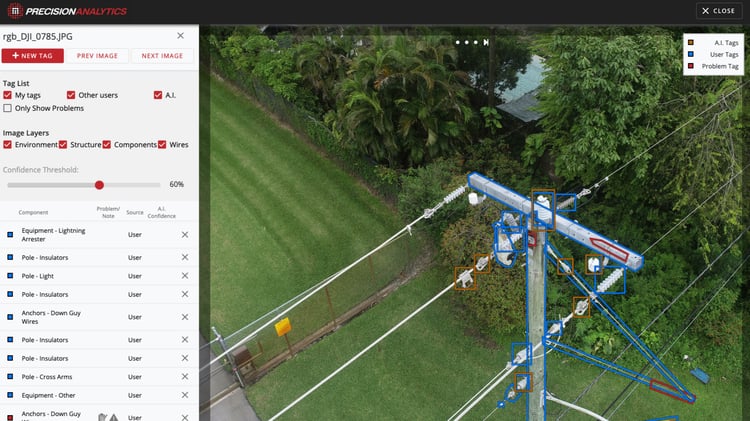The following is an excerpt from our ‘Reveal Hidden Value with Better Digital Tools to Gather, Analyze Utility Asset Data’ playbook. You can access the full version here.
 Gathering a vast amount of data about utility assets is helpful, but only if it can be processed efficiently and effectively. One way to do that is by applying artificial intelligence to sort through the information, flagging only those that need human review because of an asset discrepancy.
Gathering a vast amount of data about utility assets is helpful, but only if it can be processed efficiently and effectively. One way to do that is by applying artificial intelligence to sort through the information, flagging only those that need human review because of an asset discrepancy.

Automated, intelligent analysis not only focuses the attention of human analysts; it also helps work orders get issued faster. “A company might fly drones one day, bringing in a lot of images. But it might take two weeks for experts to manually go through it all and get work orders out,” Kristen Ellerbe, vice president of product management and design at PrecisionHawk explained.
Thus, the main benefit of applying AI to utility asset data is processing scale. “Without AI for initial image processing and analysis, a utility would need a team of dozens of people, manually examining each image for information,” said Tyler Collins, PrecisionHawk’s vice president of energy solutions. “That not only slows down the work; it introduces substantial human error.”
What’s more, AI can be applied throughout the workflow for processing asset data. For instance, computer vision is a computationally intense and logically complex process, where unstructured visual imagery is analyzed and tagged to support standardized quantifiable analysis.
This bridges the gap between the abstractions of computer science and the visually-oriented mindset of most utility engineers. The data produced from computer vision algorithms allow experts sitting at a computer to replicate the experience of walking down a street and looking up at utility poles. They can look at assets from any direction, turn them, and apply their senses, as well as knowledge, to evaluate an asset.
“That’s not the same thing as digital twin modeling, which is part of many utilities’ digitalization plans. But that’s not a shortcoming,” said Ellerbe. “Digital twins are useful but hard to understand. Computer vision is similar to what utility engineers are used to seeing every day. It adds a real-world view into asset management systems that typically reside in the model world.”
AI analysis allows utilities to set rules for which images and data are brought to the attention of human analysts, based on the level of confidence that AI algorithms assign to their assessments. For instance, a utility that has a low tolerance for thermal aberrations could specify that images or data with at least a 70% confidence rating for being out of specification are automatically routed for expert review.

“Repeated practice with large amounts of asset data, including feedback from experts, helps algorithms learn to emulate the judgment of a utility’s best employees,” said Ellerbe. “That doesn’t replace human expertise; it just helps people work more efficiently.”
Intelligent analysis of asset data can help utilities extract added value from money they’ve already spent, or have committed to spending. For instance, it can help optimize emergency response budgets. While preparing for hurricane season, a utility may need to quickly evaluate which poles are most in need of hardening. “You can turn your inventory into a system of audit,” said Ellerbe. “If you have six-month-old drone images of poles in a highly exposed part of the grid, and there’s been only one storm since then, you don’t need to spend the money or time to get crews out there to take fresh images. You can check what’s on hand, and calculate the likelihood that you’d need fresh imagery.”
The value of this kind of data grows as asset data repositories become integrated with core systems for enterprise resource planning, workforce management, and outage response. This tends to be easier when the asset data is stored in the cloud, accessible via application programming interfaces (APIs).
“Utilities need a single source of truth about their assets, so data can move easily across systems.”
- DAVID GROARKE, MANAGING DIRECTOR OF INDIGO ADVISORY GROUP
Using APIs to share asset data across departments can help utilities plan strategic capital upgrades such as hardening poles or substations, deploying energy storage, or connecting more renewable resources to the grid.
“Every utility is talking about grid modernization, but you can’t get there if you aren’t 100% certain about what you already have in the field today,” said Collins. “Robust, reliable asset data lies at the heart of rate cases and capital project planning. It’s how a utility ensures reliability and safety. It affects everything that regulators, investors, utility staff, and customers care about.”
In our playbook, Reveal Hidden Value with Better Digital Tools to Gather, Analyze Utility Asset Data, we’ll demonstrate how utilities can incorporate emerging technologies such as drones and artificial intelligence to reduce costs, improve accuracy, and prevent outages.




